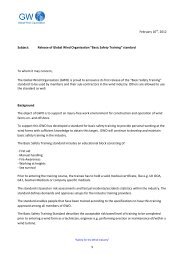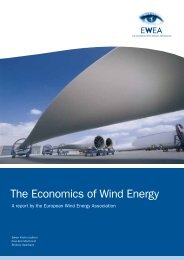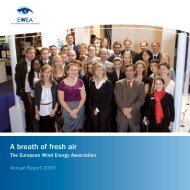Offshore Electricity Infrastructure in Europe - European Wind Energy ...
Offshore Electricity Infrastructure in Europe - European Wind Energy ...
Offshore Electricity Infrastructure in Europe - European Wind Energy ...
You also want an ePaper? Increase the reach of your titles
YUMPU automatically turns print PDFs into web optimized ePapers that Google loves.
To that extent, a 1,000 MW ‘sp<strong>in</strong>e’ was established between<br />
the Idunn hub off Norway, the Dogger Bank hub<br />
off the UK and the IJmuiden hub off the Netherlands to<br />
Belgium 31 . Sensitivities were then performed on this<br />
<strong>in</strong>itial mesh around 32 :<br />
• the effectiveness of each of the l<strong>in</strong>ks with<strong>in</strong> the<br />
‘sp<strong>in</strong>e’,<br />
• add<strong>in</strong>g additional 1,000 MW offshore l<strong>in</strong>ks to<br />
Belgium and Sweden from the IJmuiden hub and<br />
Idunn hub respectively,<br />
• add<strong>in</strong>g additional 1,000 MW offshore l<strong>in</strong>ks to Belgium<br />
and Sweden from the Dutch and Norwegian onshore<br />
networks mesh connection po<strong>in</strong>ts respectively,<br />
• uprat<strong>in</strong>g the <strong>in</strong>dividual mesh l<strong>in</strong>ks to 2,000 MW,<br />
• removal of the ‘redundant’ hub-to-hub l<strong>in</strong>k between<br />
Idunn and IJmuiden from the base model.<br />
31 As can be seen from Figure 4.23, some parts of this ‘sp<strong>in</strong>e’ already existed <strong>in</strong> the model. As a result of the hub-to-hub analysis,<br />
the Dogger Bank hub was already connected to the Gaia hub <strong>in</strong> Germany, and the Idunn hub was already connected directly to<br />
the IJmuiden hub. Belgium, France, and Sweden were already connected to the Netherlands and Norway respectively via onshore<br />
re<strong>in</strong>forcements <strong>in</strong> the base model.<br />
32 Unlike for the direct <strong>in</strong>terconnections and the hub to hub connections the possible variations <strong>in</strong> mesh topology were not exhaustively<br />
modelled although several sensitivities assess<strong>in</strong>g the effect of changes <strong>in</strong> capacities, connection po<strong>in</strong>ts and removal of l<strong>in</strong>ks around<br />
the core <strong>in</strong>itial mesh and alternative mesh designs were analysed to arrive at the design presented here. (Further details of these<br />
sensitivity studies are represented <strong>in</strong> Annex D.III.I to this report).<br />
Whilst other alternative mesh designs are certa<strong>in</strong>ly possible and may even be more beneficial, it was felt that the proposed design<br />
demonstrated the benefit of a meshed offshore grid and was already sufficiently complex to make implementation by 2030 ambitious.<br />
<strong>Offshore</strong>Grid – F<strong>in</strong>al Report<br />
Figure 4.23 shows the overall f<strong>in</strong>al grid design after<br />
step 3 of the Direct Design Methodology for the North<br />
and Baltic Seas.<br />
Results – direct design<br />
Figure 4.24 shows the <strong>in</strong>frastructure costs (cumulatively)<br />
and the total system generation costs, and Figure 4.25<br />
shows the net benefit of the overall Direct Design.<br />
As can be seen from Figure 4.24, the cumulative <strong>in</strong>vestment<br />
cost curve (blue bars) for the Direct Design<br />
is reasonably l<strong>in</strong>ear for the direct <strong>in</strong>terconnectors. This<br />
reflects the discrete <strong>in</strong>vestment required <strong>in</strong> converters<br />
and cable for every <strong>in</strong>vestment. The few larger steps<br />
for Sweden-Latvia and Ireland-France reflect the greater<br />
amounts of subsea cable required for longer <strong>in</strong>terconnections.<br />
The <strong>in</strong>vestment cost curve beg<strong>in</strong>s to plateau<br />
for the hub-to-hub cases implemented, as these require<br />
only an <strong>in</strong>vestment <strong>in</strong> extra subsea cable and utilise the<br />
FIGURE 4.24: dIREcT dESIGN - cUMUlATIvE cAPEX INvESTMENT cOSTS (blUE, lEFT) ANd SYSTEM GENERATION cOSTS (REd, RIGhT) [€ bN]<br />
Cumulative <strong>in</strong>vestment<br />
cost (blue) (€bn)<br />
8<br />
7<br />
6<br />
5<br />
4<br />
3<br />
2<br />
1<br />
0<br />
Base case<br />
SE-DE<br />
FI-EE<br />
SE-PL<br />
SE-DK<br />
SE-LV<br />
GB-FR<br />
SE-DE<br />
Cumulative <strong>in</strong>vestment costs<br />
GB-BE<br />
Direct <strong>in</strong>terconnections<br />
Hub-to-hub and Tee-<strong>in</strong> Mesh<br />
Omitted as not bene�cial. Shown to compare with direct design<br />
GB-FR<br />
SE-PL<br />
SE-DK<br />
IE-FR<br />
IE-GB<br />
GB-BE<br />
NO-NL<br />
Annual system generation costs<br />
SE-DK<br />
System generation<br />
cost (red) (€bn)<br />
NL-GB<br />
GB-DE<br />
Mesh<br />
100,5<br />
100,0<br />
99,5<br />
99,0<br />
98,5<br />
98,0<br />
63









